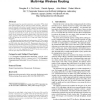Free Online Productivity Tools
i2Speak
i2Symbol
i2OCR
iTex2Img
iWeb2Print
iWeb2Shot
i2Type
iPdf2Split
iPdf2Merge
i2Bopomofo
i2Arabic
i2Style
i2Image
i2PDF
iLatex2Rtf
Sci2ools
MOBICOM
2003
ACM
2003
ACM
A high-throughput path metric for multi-hop wireless routing
This paper presents the expected transmission count metric (ETX), which finds high-throughput paths on multi-hop wireless networks. ETX minimizes the expected total number of packet transmissions (including retransmissions) required to successfully deliver a packet to the ultimate destination. The ETX metric incorporates the effects of link loss ratios, asymmetry in the loss ratios between the two directions of each link, and interference among the successive links of a path. In contrast, the minimum hop-count metric chooses arbitrarily among the different paths of the same minimum length, regardless of the often large differences in throughput among those paths, and ignoring the possibility that a longer path might offer higher throughput. This paper describes the design and implementation of ETX as a metric for the DSDV and DSR routing protocols, as well as modifications to DSDV and DSR which allow them to use ETX. Measurements taken from a 29node 802.11b test-bed demonstrate the ...
| Added | 05 Jul 2010 |
| Updated | 05 Jul 2010 |
| Type | Conference |
| Year | 2003 |
| Where | MOBICOM |
| Authors | Douglas S. J. De Couto, Daniel Aguayo, John C. Bicket, Robert Morris |
Comments (0)

